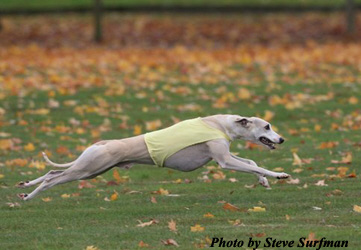As a breed Whippets run the most consistently. There are very few that don’t complete a course, don’t run or don’t seem to really want to get “the bunny”. When I am judging I tend to keep my scores numerically close unless there is something glaring that causes me to have more than a two or three point spread between the dogs. That way a dog that puts in two good runs in the preliminaries and finals rises to the top. There can be ties this way, but I find that when they run off they are very close and there was a reason they were tied.
COVER ~ CONTENTS ~ ARCHIVES ~ CREDITS ~ LINKS ~ BACK COVER ~ CONTACT US
PAGE 2
The object of this “game” is to catch the lure/prey. When watching a course I look for the dog that not only has the drive to catch but also the skills to be able get the prey. These skills are included in the categories of enthusiasm, follow, speed, agility, and endurance. Our courses are not that long so most dogs get an equal score in endurance. Unless a dog stops or gets unsighted for no reason most dogs get and equal score in enthusiasm. The variances in dog’s scores are usually
in the categories of follow, speed and agility.
Each breed that lure courses has a different running and hunting style that they were bred for. Therefore I look at them a little differently. The consistent thing is the object of the chase. Greyhounds, obviously, are the closest in running style to Whippets, but they are not nearly as agile.
A judge not only has the responsibility of scoring the hounds but also for their safety. That’s one of the reason a judge always walks the course before any dogs are run. During the trial this responsibility for safety includes dismissing hounds

that interfere with other hounds, stopping a course if a dog is injured, letting a lure operator know if you feel they are endangering the dogs.
When running my own dogs I find, unless I am making a conscious effort to view the course as a judge, I look at my own dog’s course differently. When watching your own dog running you are primarily watching its run with respect to how it’s run in the past.
NEXT PAGE
